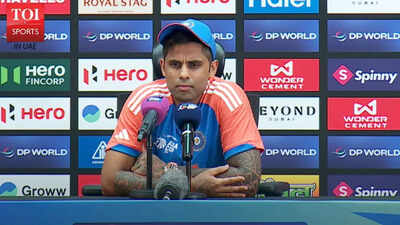Only a week after his bid to reach his first Super Bowl ended in playoff heartbreak in the Buffalo snow last January, Derrick Henry decided he had rested his body long enough.
The bruising Baltimore Ravens running back showed up in workout gear to the Dallas facility where he trains every offseason.
Advertisement
“I’m thinking he came in to say, ‘What’s up? I’m back in Dallas. Let’s reconnect and start talking about what our strategies are going to be for the offseason,’” friend and trainer AJ Billings told Yahoo Sports. “Nope. He said, ‘Let’s get to work. I’m ready to go.’”
Stories like that exemplify how Henry has so far stiff-armed Father Time the same way he does an overmatched would-be tackler. The 31-year-old is a relentless worker who spends a reported $240,000 per year on body maintenance. He has extended his peak into his early 30s because of his voracious two-a-day offseason workout schedule, his dedication to a disciplined diet and his emphasis on healing and recovery.
The shelf life for workhorse running backs is notoriously short. Todd Gurley went from first-team all-pro at 24 to out of football at 26. Le’Veon Bell and Ezekiel Elliott took their last NFL handoffs at 29. Melvin Gordon was 30. And yet here is Henry still bulldozing defenders, still as powerful and nimble as ever.
Last season, Henry piled up 1,921 rushing yards, breaking Tiki Barber’s single-season record for running backs 30 or older. He was so dominant that the Ravens rewarded him with a two-year, $30 million contract extension, a big-money bet that the five-time Pro Bowler can continue to dominate through his age-33 season in 2027.
Advertisement
That looks like a shrewd gamble one game into the 2025 season. Henry was unstoppable in a season-opening 41-40 loss at Buffalo last Sunday night, ripping off a pair of long touchdown runs on his way to 169 yards on 18 carries. The only blemish was a critical late-game fumble that helped the Bills rally from a 15-point fourth-quarter deficit.
If Henry’s age-defying opening-night performance is any indication, he has a chance to reshape conventional wisdom for what a greybeard running back can accomplish. Only four players in history have rushed for more than 5,000 yards after turning 30. Only Frank Gore eclipsed 6,000. Henry could potentially be more than halfway to Gore’s record of 7,161 yards by the end of this season.
Derrick Henry spends part of his offseason training running hills in the Dallas area. (Courtesy of AJ Billings)
“S—, I’ve been training him for eight years and I keep telling people he’s better now than he was three or four years ago,” trainer Melvin Sanders told Yahoo Sports. “People look at me like I’m crazy for saying that, but it’s true. The reason is he’s taking better care of his body. That’s why he’s able to perform at the level he’s performing at right now.”
Advertisement
The first time either Billings or Sanders met Henry, the running back had just finished his rookie season with the Tennessee Titans. Henry’s girlfriend Adrianna Rivas was taking spin classes at SandersFit Performance Center, a state-of-the-art 12,000-square-foot Dallas gym that Sanders had opened. She explained that her boyfriend played football and asked if he could stop by for a trial workout.
“Here comes this big, young guy,” Billings recalled with a laugh. “I was like, ‘Oh my God.’”
By then, Henry was already well known in football circles. As a 6-foot-3, 240-pound high school running back in the Jacksonville suburbs, Henry piled up 12,000-plus yards and left a trail of demoralized players and dumbfounded coaches in his wake. Henry then added to his legend one stiff arm at a time in his first season as a full-time starter at Alabama, steamrolling his way to the 2015 Heisman Trophy and helping the Tide capture Nick Saban’s fifth national title.
Henry slipped to the second round of the 2016 NFL Draft amid concerns about his high running style, below-average quickness and limited pass-catching ability. He split carries with veteran DeMarco Murray his first two seasons with Tennessee, flashing talent but never seizing the full-time job.
Advertisement
Establishing himself as an every-down workhorse was Henry’s goal when he began training with Billings and Sanders each offseason at their Dallas gym. Henry bonded quickly with both men, Billings a former East Texas A&M defensive back and Sanders a former journeyman professional basketball player who played 16 games with the San Antonio Spurs.
To Sanders, what separated Henry from other clients was more than just his unique combination of breakaway speed, sledgehammer power and surprising agility. Henry also possessed a hunger to be great, so much so that he’d often put up a fight after offseason two-a-day workouts when Sanders told him to pack up and go home.
“We used to do three-a-days,” Sanders said with a laugh. “That’s when I knew he was different.”
A staple of Henry’s highest-intensity offseason workouts are sprints and agility drills up some of the Dallas area’s steepest, most punishing hills. Billings assigns Henry 12 sprints, the latter set of six pulling a 45-pound metal chain behind his back to simulate a defender trying to yank him down.
Advertisement
“We always end up doing about 20 of those,” Billings said. “He’ll do one and then insist on doing it over because he doesn’t like the intensity.”
The most fearsome of all the hills is one known as “Big Bertha,” a 200-yard monster off Interstate-45 that Billings says “kind of digs and grinds and gets steeper and steeper the higher you get.” That’s the hill that Billings saved for the final two weeks before training camp this summer. Once or twice a week, at sunrise, Henry was out there, sweating, gasping … but smiling.
If sprinting up hills with Billings isn’t the most jaw-dropping aspect of Henry’s offseason training, then it’s the strength and mobility training the running back does with Sanders.
Advertisement
How many other humans can pull off a 54-inch box jump?
And these single-leg squats?
And these pushups with their feet on an exercise ball, their hands on a chaos band and a heavy chain draped around their neck?
Said Sanders with a laugh, “Someone coming in and watching for the first time, they’re probably like holy s—.”
At the height of his tenure with the Tennessee Titans, Henry challenged the limits of how much workload a bellcow running back could withstand without enduring a sharp decline the following season, either due to major injury or loss of effectiveness. He won back-to-back rushing crowns, carrying the ball 386 times, including the playoffs, in 2019 and then 396 times, including the playoffs, in 2020.
Advertisement
The following offseason, with Henry’s 30th birthday less than three years away, Sanders pulled the running back aside. The trainer told Henry he needed to improve his diet if he was going to play another 5-10 years.
It would have been easy for Henry to blow Sanders off while basking in the afterglow of the eighth 2,000-yard rushing season in NFL history. To Henry’s credit, he did exactly the opposite. He hired a private chef and nutritionist. He started eating more lean protein and less carbs. He cut dairy, gluten, fried foods and artificial sugars out of his diet altogether.
Henry is now so strict that his cheat days consist of an occasional waffle or slice of french toast with breakfast during the offseason. Not even Billings can tempt him to relax.
“I’ve tried,” Billings said. “We’ve been to steak dinners. We’ve been out late-night. I’ve said, ‘Hey man, try a piece of this cake. It’s amazing.’ And he doesn’t. So I commend him for having so much discipline.”
Advertisement
The other change that Henry’s team of trainers implemented as he approached his 30s was to dial back the frequency of his high-intensity workouts in an effort to save his legs. Apps that analyze heart rate variability and sleep quality and duration help Billings and Sanders decide when to push Henry and when to engage in active recovery.
Henry also spares no expense with treatments that reduce joint and muscle pain, inflammation or soreness. He might book an hour-long session in a hyperbaric chamber to reap the recovery and performance benefits of breathing pure oxygen at a higher pressure than normal. Or he might schedule massage therapy, a cold plunge, red light therapy or time in an infrared sauna to heal his body after a punishing game or a challenging workout.
Everything is geared toward sticking it to the NFL pundits and fantasy analysts who annually insist that he’s overdue for a steep decline. Everything is geared toward defying the rival teams who passed on him in free agency in 2024 because of his age and workload.
Advertisement
And, above all else, everything is geared toward helping Henry cross off the one unachieved goal on his career check list: winning a Super Bowl.
Two months ago, during an interview on The Rich Eisen Show, Henry acknowledged that his motivation last season was “to prove that I could still do it in this league and be a great player.” Entering this season, the chip on his shoulder is more team-oriented. Henry feels that when the Ravens lost in Buffalo in the playoffs last January, they “left some stuff on the table last year that we feel like we should have accomplished.”
“I feel like we have everything we need to win a Super Bowl, to win a championship,” Henry said. “And I feel like the whole team should have that chip on their shoulder for us to go out there and prove that.”
How much longer will Henry chase that elusive Super Bowl ring? He told Eisen he doesn’t have a retirement timetable in mind.
Advertisement
“Whenever I feel like it’s time to hang ‘em up, I’m gonna hang ‘em up,” Henry said. “Until then, you’re going to see me.”
The way his trainers see it, Henry is capable of playing at a Pro Bowl level into his mid-30s. Unless he decides he wants to devote all his time to Rivas and their two daughters, opposing defenders may be fending off Henry’s trademark stiff arms for a while.
“He’s always chasing greatness,” Sanders said. “The desire to be one of the best ever, that’s really what drives him.”





